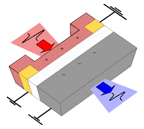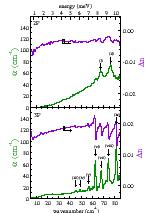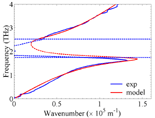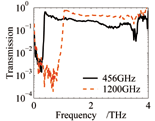- Current Research > Terahertz spectroscopy
-
For enquires please contact Michael Johnston.
- Hole trapping in polymer transistors
-
 |
The research of polymer-based transistors is leading to the development of flexible, printable circuitry, that is extremely cost effective to manufacture. However, the long-term performance of state-of-the-art polymer field effect transistors (pFETs) is limited by device degradation. We have shown that terahertz spectroscopy is an ideal tool to probe polymer device performance. Specifically, we have monitored charge carrier trapping at the polymer-insulator boundary of a pFET. From these results we show that device degradation is primarily caused by a trapping of holes in the channel of the pFET, rather than by a change in hole mobility.
See:
- Appl. Phys. Lett., 89 (2006), [
bib | http | .pdf
]
THz-TDS was used to measure the charge density of holes in the conductive channel of polymer transistors (F8T2 on silicon gate) during device operation.
|
- Charge carrier dynamics in multi energy ion-implanted semiconductors
-
|
Damaging a semiconductor crystal by bombarding it with energetic ions can create defects that
trap and scatter photoexcited carriers on ultra-short timescales. By optimising parameters such as
incident ion dose, ion energy and post-implant anneal temperature it is possible to create materials
with short (sub-picosecond) carrier lifetimes, and high mobilities. This creates semiconductors suitable
for applications in ultra-fast opto-electronics, such as terahertz emitters.
We can obtain the lifetime of photoexcited carriers in ion-implanted semiconductors using our optical-pump,
terahertz probe spectroscopy setups. In the Figure (right) the lifetimes for InP samples implanted with Fe or O ions with various ion doses and annealing temperatures are shown.
|  |
- Vibrational modes and conformational transitions in organic materials (phenyelene oligomers)
-
 |
Research into conjugated polymers and molecules is leading to the
development of new, cost effective electronic and optoelectronic
devices. THz spectroscopy is proving to be a sensitive probe of the electronic and vibrational properties of these organic materials.
For example we have studied low energy vibrational modes in pheylene oligomers (biphenyl, terphenyl, quarterphenyl and sexiphenyl) using THz-TDS. This has allowed us to identify a torsional mode that is important for the molecules' electronic properties. We have also used the technique to observed a temperature dependent structual phase transition.
See:
- Chem. Phys. Lett., 377 (2003), p. 256. [
bib | http | .ps.gz | .pdf
]
THz-TDS applied to organic molecules (phenylene oligomers). Also include a diagram of our THz-TDS experiment
|
- Phonon polariton modes
-
 |
The dispersion of light as it couples to TO phonon modes in polar crystals is well described
by the Drude-Lorentz oscillator dielectric function. The ability of THz-TDS to detect electric field
amplitudes (rather than intensities) enables the dielectric function of a material to be determined directly
from one experiment. An example of this is shown on the left, namely the phonon-polariton dispersion of CsI,
which has its TO-phonon at 1.8THz.
|
- Characterisation of far-infrared filters for particle accelerator diagnostics
-
 |
The temporal beam profile of electron beam bunches in free-electron lasers can be determined
by examining their emitted coherent Smith-Purcell radiation at far-infrared (terahertz) frequencies.
We characterised a number of band-pass filters made from wire-grid polarisers, and waveguide array
plates, which are necessary in the apparatus that detects Smith-Purcell radiation. Some example transmission
spectra through waveguide array plates are shown on the left.
|
|
|


